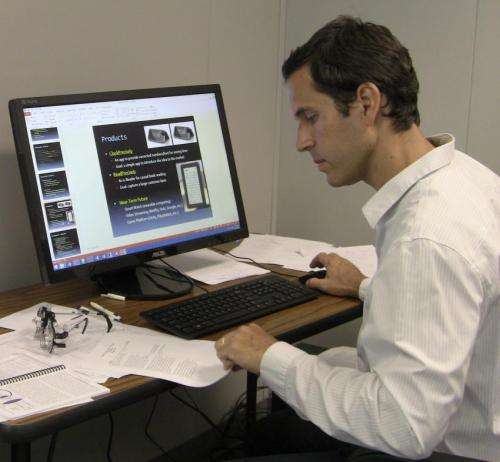New technology could make digital text, images on computer screens easier to see

CPrecisely, a Purdue Research Park-based company, is developing technology to allow people to see digital content with increased sharpness on displays like tablets, smartphones and laptops without the need for corrective eyewear, according to a company official.
CPrecisely was co-founded by Daniel Aliaga, chief executive officer and associate professor in Purdue's Department of Computer Science, Chris May, chief technology officer, and Ignacio Garcia-Dorado, chief science officer.
Aliaga said 75 percent of people in the United States need corrective eyewear.
"From the age of 45, people inevitably start to suffer from presbyopia - a condition in which the lens of the eye gradually loses its ability to focus, making it difficult to see objects up close," he said. "This means they will need reading glasses in their day-to-day lives. This creates a greater need for a more efficient way to see content on electronic devices."
The CPrecisely development team has created corrective imaging technology that helps a person with visual impairments to see electronic images or text properly.
"Our approach exploits the way the uncorrected eye incorrectly focuses light rays. These images look clear to a person who isn't wearing their corrective eyewear, but they look strange to people with 20/20 vision," he said. "It corrects the image according to the user's eyesight, making it a personalized solution. It uses existing digital displays and projectors, so there is no specialized hardware to purchase."
Aliaga said there are two equally important parts to developing CPrecisely's business: software development and content availability. He said the software soon will be complete and distributed through app stores such as Apple iTunes and Google Play. Aliaga and his colleagues now are looking to collect content.
"First, we are going to focus on public domain content," he said. "After we do that, we hope to connect with publishing companies to inquire about re-selling their content with our image correcting technology. Customers would be able to apply our technology to their current or new e-books."
Aliaga said the Purdue Office of Technology Commercialization and the Purdue Foundry have helped in commercializing innovations and encouraging startups and entrepreneurship.
"The Purdue Foundry helped us in the development of our business plan while OTC helped the inventors apply for a patent, which was then licensed exclusively to CPrecisely," he said.
The technology has been exclusively licensed to CPrecisely through the Purdue Office of Technology Commercialization.
More information: www.cprecisely.com/
Provided by Purdue University




















